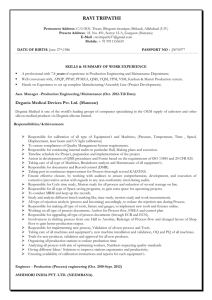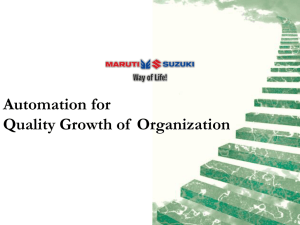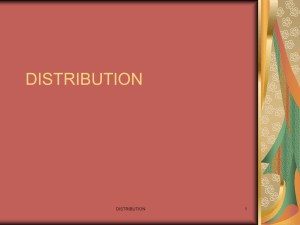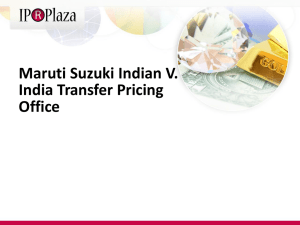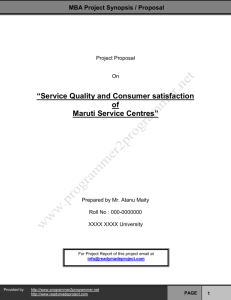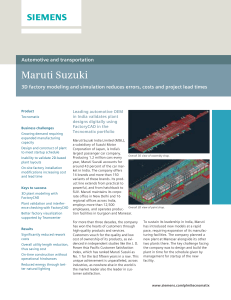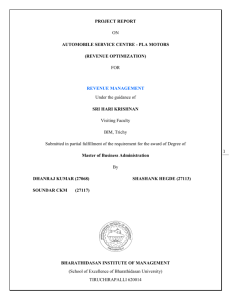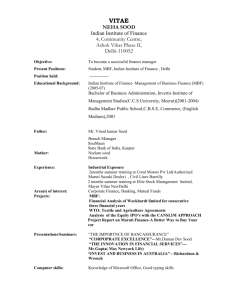marketing strategies of maruti suzuki limited
advertisement
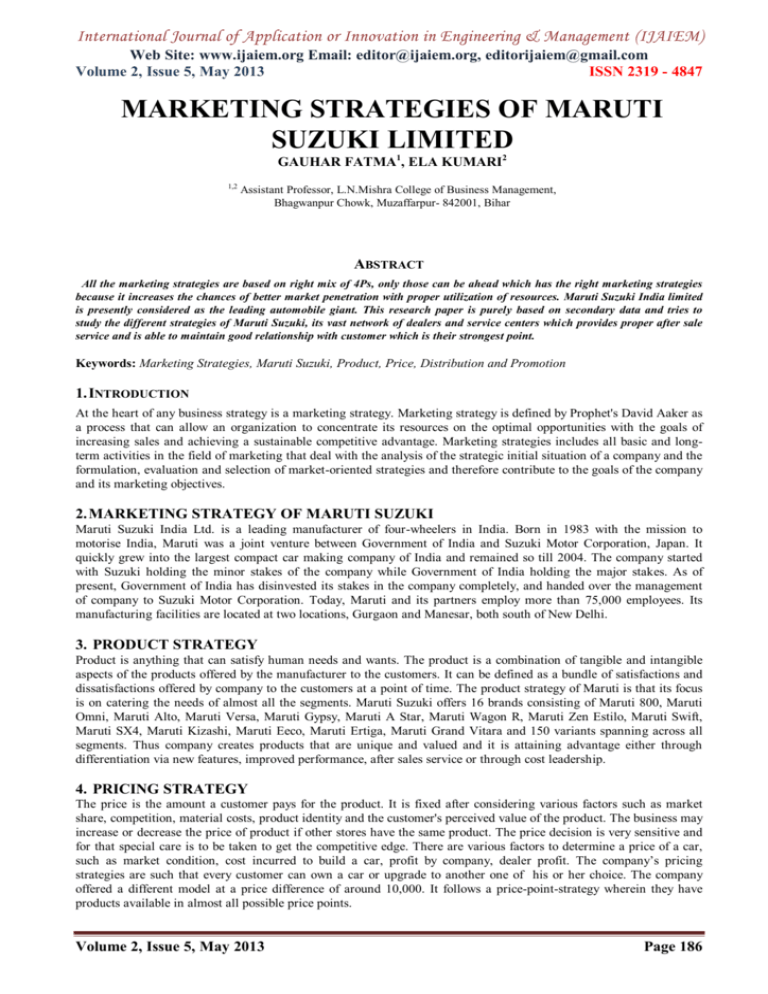
International Journal of Application or Innovation in Engineering & Management (IJAIEM) Web Site: www.ijaiem.org Email: editor@ijaiem.org, editorijaiem@gmail.com Volume 2, Issue 5, May 2013 ISSN 2319 - 4847 MARKETING STRATEGIES OF MARUTI SUZUKI LIMITED GAUHAR FATMA1, ELA KUMARI2 1,2 Assistant Professor, L.N.Mishra College of Business Management, Bhagwanpur Chowk, Muzaffarpur- 842001, Bihar ABSTRACT All the marketing strategies are based on right mix of 4Ps, only those can be ahead which has the right marketing strategies because it increases the chances of better market penetration with proper utilization of resources. Maruti Suzuki India limited is presently considered as the leading automobile giant. This research paper is purely based on secondary data and tries to study the different strategies of Maruti Suzuki, its vast network of dealers and service centers which provides proper after sale service and is able to maintain good relationship with customer which is their strongest point. Keywords: Marketing Strategies, Maruti Suzuki, Product, Price, Distribution and Promotion 1. INTRODUCTION At the heart of any business strategy is a marketing strategy. Marketing strategy is defined by Prophet's David Aaker as a process that can allow an organization to concentrate its resources on the optimal opportunities with the goals of increasing sales and achieving a sustainable competitive advantage. Marketing strategies includes all basic and longterm activities in the field of marketing that deal with the analysis of the strategic initial situation of a company and the formulation, evaluation and selection of market-oriented strategies and therefore contribute to the goals of the company and its marketing objectives. 2. MARKETING STRATEGY OF MARUTI SUZUKI Maruti Suzuki India Ltd. is a leading manufacturer of four-wheelers in India. Born in 1983 with the mission to motorise India, Maruti was a joint venture between Government of India and Suzuki Motor Corporation, Japan. It quickly grew into the largest compact car making company of India and remained so till 2004. The company started with Suzuki holding the minor stakes of the company while Government of India holding the major stakes. As of present, Government of India has disinvested its stakes in the company completely, and handed over the management of company to Suzuki Motor Corporation. Today, Maruti and its partners employ more than 75,000 employees. Its manufacturing facilities are located at two locations, Gurgaon and Manesar, both south of New Delhi. 3. PRODUCT STRATEGY Product is anything that can satisfy human needs and wants. The product is a combination of tangible and intangible aspects of the products offered by the manufacturer to the customers. It can be defined as a bundle of satisfactions and dissatisfactions offered by company to the customers at a point of time. The product strategy of Maruti is that its focus is on catering the needs of almost all the segments. Maruti Suzuki offers 16 brands consisting of Maruti 800, Maruti Omni, Maruti Alto, Maruti Versa, Maruti Gypsy, Maruti A Star, Maruti Wagon R, Maruti Zen Estilo, Maruti Swift, Maruti SX4, Maruti Kizashi, Maruti Eeco, Maruti Ertiga, Maruti Grand Vitara and 150 variants spanning across all segments. Thus company creates products that are unique and valued and it is attaining advantage either through differentiation via new features, improved performance, after sales service or through cost leadership. 4. PRICING STRATEGY The price is the amount a customer pays for the product. It is fixed after considering various factors such as market share, competition, material costs, product identity and the customer's perceived value of the product. The business may increase or decrease the price of product if other stores have the same product. The price decision is very sensitive and for that special care is to be taken to get the competitive edge. There are various factors to determine a price of a car, such as market condition, cost incurred to build a car, profit by company, dealer profit. The company’s pricing strategies are such that every customer can own a car or upgrade to another one of his or her choice. The company offered a different model at a price difference of around 10,000. It follows a price-point-strategy wherein they have products available in almost all possible price points. Volume 2, Issue 5, May 2013 Page 186 International Journal of Application or Innovation in Engineering & Management (IJAIEM) Web Site: www.ijaiem.org Email: editor@ijaiem.org, editorijaiem@gmail.com Volume 2, Issue 5, May 2013 ISSN 2319 - 4847 Table 1: Models with Price Range Car Models (Maruti) Price Range (Rs.) Maruti 800 2,10,027 - 2,32,610 Maruti A-Star Maruti Alto 800 Maruti Alto K10 Maruti Eeco Maruti Ertiga Maruti Grand Vitara Maruti Gypsy Maruti Kizashi 3,81,171 - 4,66,219 2,42,775 – 3,56,775 3,21,358 - 3,34,598 3,05,675 - 4,10,893 5,98,970 - 8,70,970 22,68,064 - 24,60,529 5,51,409 - 6,01,057 16,52,875 - 17,52,875 Maruti Omni 2,17,655 - 2,82,013 Maruti Ritz 4,32,237 - 6,33,612 Maruti Swift 4,48,893 - 6,87,768 Maruti Swift Dzire 4,92,354 - 7,50,483 Maruti SX4 7,38,114 - 9,79,786 Maruti Wagon R 3,57,880 - 4,44,674 Maruti Zen Estilo 3,45,829 - 4,36,136 Source: www.cardekho.com/Maruti/carmodels/pricerange Maruti – 800 is the lowest price model of this company. Grand Vitara is the high price model of the company. 5. DISTRIBUTION STRATEGY Distribution strategy of a firm is a plan created by the management of a manufacturing business that specifies how the firm wishes to transfer its products to intermediaries, retailers and end consumers. Maruti Suzuki has two manufacturing facilities in India. Both manufacturing facilities have a combined production capacity of 14,50,000 vehicles annually. Maruti has a strong dealer network. Infact it was one of the very first companies in the country to understand the importance of after sales service in high involvement products like cars. It has the largest distribution & Service network comprising of over 400 sales showrooms, over 600 dealer workshops, and 1900 Authorized Service Stations spanning across over 1190 cities unparalleled in the country. It has 30 Express Service Stations on 30 National Highways across 1,314 cities in India. Most of the service stations are managed on franchise basis where Maruti trains the local staff. To increase their reach to rural India, where setting up a complete dealership was very difficult, they opened extension counters which are operated by some dealer in the city thereby ensuring increased customer touch points without risking the viability of the dealers. Table 2: Network Details Years Sales Outlet Cities Dealer Covered By Sevice Sales Network 2007-2008 600 343 683 2008-2009 681 454 779 2009-2010 802 555 906 2010-2011 933 668 1101 2011-2012 1100 801 1305 2012-2013 1204 874 1415 Source: www.marutisuzuki.com/our-network.aspx Maruti Authorised Service Cities Covered By Service True Value Outlets Cities Covered By True Value 2628 2767 2740 1845 1653 1514 1220 1314 1335 1395 1408 1423 266 315 341 358 409 456 166 181 198 208 233 256 6. PROMOTION STRATEGY The promotion includes all communications a marketer used in the market for his products and services to create awareness, to persuade the customers, to buy and retain in future also. For improvement in the position of sales or progress of business this method is used. The message is given to target group regarding the features and benefits of the products or services. Without communication, the features, benefits and schemes would not be known to the customers Volume 2, Issue 5, May 2013 Page 187 International Journal of Application or Innovation in Engineering & Management (IJAIEM) Web Site: www.ijaiem.org Email: editor@ijaiem.org, editorijaiem@gmail.com Volume 2, Issue 5, May 2013 ISSN 2319 - 4847 and objectives of launching of products or services and increasing sales would not be completed. When communication creates awareness then only the interest would be created and customers would take the decision for buying. For promotion different methods of communication can be used. The promotional strategy of Maruti Suzuki is very effective. The company emphasise on road safety and environment friendly products. The company has launched road safety mission under which 5,00,000 people will be trained in the next three years. This will be done through two channels - Institute of Driving Training and Research (IDTR) and the Maruti Driving Schools spread across the country. Of the 5, 00,000 people to be trained, at least 1,00,000 will be people from underprivileged section of society, who are keen to take driving as a profession. The company has always promoted the concept of "Reduce, Reuse, Recycle" (3R's). The company has taken help of all the promotional tools like radio, television, road shows, print media, workshops and seminars to promote their cars 6.1 ROAD SHOWS: The Company organizes road shows to display vehicles in the pavilions during various college festivals and exhibition. 6.2 RADIO: Radio is one of the biggest medium to communicate. The company goes for radio announcements to convey about the product features, price, qualities, etc. 6.3 PRINT MEDIA: The company also promotes with the help of print media .Advertisement is given in leading newspapers as well as they distribute brochures and leaflets at public places to reach the customers.At times they organize workshops and seminars to display their models and they also offer test drive. The company also advertises through banners and posters. 7. CONCLUSION The Maruti Suzuki has a huge market and has left no stone unturned to satisfy the customers. It has models in every segment of the automobile market. Maruti Suzuki stands for value as much as it stands for performance. In spite of rising input costs, the company tries their best to keep prices down. Their running costs and resale values are unbeatable too. Competitive strategy of this company facilitated healthy profit and customer satisfaction and its recognition as a company which stands for environmental concerns. Nothing matches the delight their cars deliver. In fact, customer they don’t buy a Maruti Suzuki, they invest in it. REFERENCES [1]. Ramaswamy,V S & Namakumari, S (2009), Marketing Management: Global Perspective, Indian Context(4th edition)., Macmillan Publishers India Ltd Ch-3, pg-33. [2] Neelamegham, S (2012), Marketing India (4th edition), Vikash Publication, New Delhi [3] http://www.businessdictionary.com/definition/distribution-strategy.html#ixzz2T3s4MWsu [4] http://www.scribd.com/doc/52392026/Maruti-Suzuki-Advertising-Strategies [5] http://www.businessdictionary.com/definition/distribution-strategy.html [6] http://www.slideshare.net/saurabhkumarlohal/marketing-strategy-of-maruti-suzuki [7] http://rajeshaithal.blogspot.in/2007/10/price-point-strategy_31.html [8] http://en.wikipedia.org/wiki/Marketing_strategy [9] http://www.marutisuzuki.com/Latest-Maruti-Company-Update.aspx [10] http://shodhganga.inflibnet.ac.in/bitstream/10603/3704/13/13_chapter%203.pdf [11] http://www.cardekho.com/Maruti/carmodels/pricerange [12] http://www.marutisuzuki.com/our-network.aspx AUTHORS Gauhar Fatma pursued MBA in Marketing from L.N. Mishra, Patna and served as a Guest Lecturer at L.N. Mishra and Anugrah Narayan College, Patna, in order to excel in corporate vision worked with Advantage Media Consultants and ICICI bank and currently sharing her experiences with students as an assistant professor in L.N. Mishra College of Business Management, Muzaffarpur. Ela Kumari pursued MBA in Marketing from Xavier Institute of Social Service, Ranchi and worked in corporate for couple of years then she shifted to academics and worked in Academy of Technology and Management College, New Delhi as a lecturer for 2 years and presently she is working as an Assistant Professor in L.N. Mishra College of Business Management, Muzaffarpur. Volume 2, Issue 5, May 2013 Page 188
